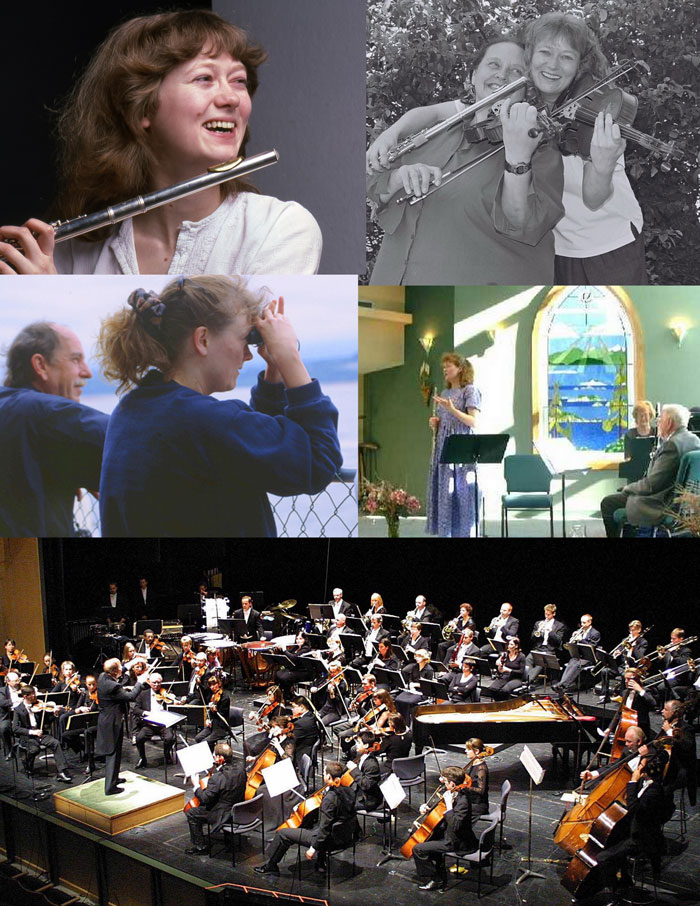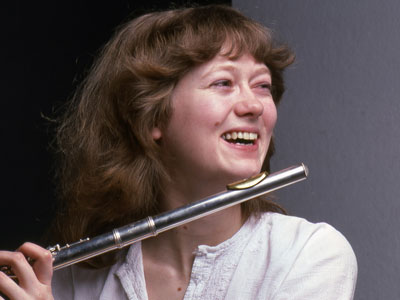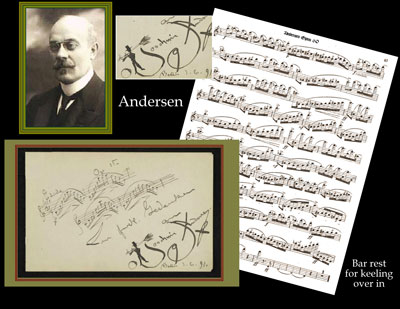I never thought I would have the opportunity to speak with Jen Cluff–amazing flute blogger, performer, teacher, and person. Though she warrants no introduction, Jen was Principal Flute of The Vancouver Island Symphonyfrom 1995 to 2006 & was Instructor of flute at Vancouver Island University 1993-2013. She currently teaches at The Conservatory of Music in Nanaimo, B.C. Canada.
Whenever I have an issue I’m working through on my own, I always consult her blog for an answer. She has amassed the most comprehensive and thorough resource for flute teaching online. I want to extend a huge thank you to Jen for her time working with me on this article. I’ve truly enjoyed getting to know more about her and feel inspired to start 2016! — Amanda
The Flute Examiner Interviews Jennifer Cluff – Canadian Flute Teacher and Performer – Dec. 16th 2015

1. Why blog as a teaching tool?
Before the internet existed I was a letter writer. I actually had penpals. I wrote to knowledgable people to ask them formal questions. I wrote a lot to friends. When I began teaching I was an instant flute sleuth, seeking answers to flute questions, and ordered hard-to-find flute books from the library, reading them cover to cover, and taking notes of the best teaching tips. And I tested those teaching tips, and shared them with my students, seeing which ideas really worked, and which ones suited which level of flutist. It’s intricate work that fascinates and this is basically what I’m still doing today.
If I encountered a teaching mystery with an individual student, I would be curious enough to phone fellow-flute-teachers and get advice and share stories of student mysteries“break throughs” with any flute teachers I met.
If I had a problem with a score or preparation of a tricky orchestral part, or when I had an injury, I would actually write snail-mail letters to famous flutists or to flute music publishers or flute-makers in order to retrieve the most up-to-date information about the ever changing, often tricky but perpetually mysterious world of flute. So, before the internet I was already a keen communicator.
Once flute discussion groups appeared online, through the early 2000s, the more questions and answers I read from teachers just like me, the more knowledge I had to test and pass along. If some particular advice worked well with several students, then I’d check it with other teachers to see if it worked for everyone.
This led to a body of up-to-date knowledge in typical flute problems and solutions.
So I uploaded the descriptions of the flute-investigative work I did and still do, to a website, for all flutists to share. At first it was just a brightly coloured text-only website with copied and pasted questions and answers from a decade of questions asked on flute email groups. Now I simply put all new articles on a blog which is easy to use.
If it’s a common question, pertinent to any flutist’s development, I blog about it.
I know that there will be future flutists interested in finding these same classic questions and answers. So I make the information findable for newcomers. It’s fun to sleuth out rare music and speak with and email flute experts.
While others may do crossword puzzles for relaxation, I do the “Hercule Poirot” sleuthing, but on flute topics. It’s a second, more relaxing hobby in addition to actually practicing, writing music for, and teaching the flute.
I know; super keener; eek! :>)
2. When (and why) did you start your blog?
In the early days of the internet, in several “Flute Email Discussion Groups” online, there were from one to two thousand flutists online trading information. Because I’d learned to speedtype, I started answering novice and intermediate questions in these groups, because so many of my students asked the same questions and I wanted the input from other teachers on the current state of: “Do I need a B-foot? Is gold better? How can I enjoy etudes and scales so that I actually do them everyday? Do I need a new flute now or have I worn my old one out?” These are some of the most common questions. And because there were still so many flute myths out there in the world that needed to be updated and corrected, I was also energized to be a flute myth buster.
The more people that come online the more certain myths (such as “don’t use the B-flat thumb key, it is cheating!” “keep your elbows high” and “pinch your lips tightly for high-notes”) would have to be traced to their source in order to figure out why the myths were still so popular. It’s interesting to watch myths become real information finally. It’s the evolution of human communication and teaching psychology at its finest.
Add a thousand new flutists to the internet every year, and give them a forum to ask questions, and it immediately becomes obvious that there are only about one hundred of the most common questions.
And yet there are new things every year; there are new individuals with interesting perspectives to offer online; I enjoy it all.
When I find a flute fact I share it. I check it for myself at the music stand. Sometimes I write out whole exercises in notation, then test them and record them and listen back. When I find a flute technique that works, I share it for free because I want to know: Does it work for everyone? Is this really the most helpful way to communicate this? How do people understand this? What’s the best way to say this? That keeps me interested in sharing it all.
3. In my opinion, you have the most extensive and interesting range of topics. How do you keep it going? Have you had any “hiccups,” or obstacles trying to keep it up?
It’s almost impossible to make a website or blog the total center of your spare time when you’re teaching, performing and also having a normal life around practicing for 2+ hours a day. So now that I’m writing a book (“The Craft of Playing the Flute” coming soon if I ever get there), I no longer post on the blog every four days as I did at first. But there are plenty of years worth of archives to hold newcomer’s interest while I turn to music copying work. I spend most of my time playing and writing music these days.
I also spend a great deal of time testing my newly written flute duets and exercises and trios with my own students, and have several chamber groups of flutists going at the moment, so that uses my time well, instead of blogging about fingerings and embouchure warmups.
But whenever I have a gigantic breakthrough on a flute idea, I go straight to my blog and put the links and explanations, so others can read it right away. So all this has to be balanced.
I’ve rarely had a hiccup or obstacle to blogging; perhaps it’s because I refuse to be a number-watcher and I’ve never agreed to the idea that I must blog constantly.
I don’t check the numbers of visitors or any other stats. And I don’t feel I am responsible for “endless growth” or any kind of mercantile efforts; so I’m free to do as much or as little as I want because I don’t want any stress about it. That’s my philosophy for all the Arts, too.
I have to leave time for reading and knitting and cooking and walking, which are also part of the balance.

4.What was your most “fun” article to write?
I got a huge kick out of writing the musical notation for a bunch of scale and arpeggio handouts for novices and intermediates. I think it was almost fifty pages of music, set up in response to a James Galway Scale Challenge. Galway had asked students to join him in playing Moyse’s “Exercises Journaliers”’ every morning for a month, and then to report back on their improvements. However I immediately saw that this would be too difficult for the bulk of the adult novices who I knew were silent readers as members of the Galway Chat Group, so I literally went into a fever of creativity and re-wrote the Moyse exercises to simplify them so that everyone could play them. I put them up on my blog and anyone could freely join in. I was thrilled with the project, and it was very creative. What drove me was the speed of completing it in time for everyone to try the challenge.
Another truly fun blog was interviewing a former summer masterclass student of Moyse for a series called “Pearls of the Masters” on my blog; hearing all about what it was like to actually live in and go to masterclasses everyday and what Moyse was really like was engaging. I truly enjoyed that series.
I like talking back and forth best, not just talking to myself on my blog. Ha ha.
5.What bit of advice would you give to a young flutist who is thinking of blogging?
Practice first. Live first. Only blog when you’re really moved to share. Quality beats quantity every time.
6.Tell us about your new book coming in 2016. Where can we find it once it’s published?
When and if I ever finish my vastly expanding book I will immediately announce it to all the flute groups, so no worries; the announcement will find all flutists. And I’ll simply have the book as a purchasable pdf on my blog, just like the Roger Mather book “The Art of Playing the Flute” is there now, in the sidebar.
http://jennifercluff.blogspot.ca/
You’ll be able to see that the book is for sale just by googling my name.
But don’t hold your breath; or at least use your breath for some great Bach or something in the meantime because it takes a great deal longer than I thought to be this comprehensive.
7. How do you organize (and gather) your resources?
Because I was born in the ’60s, I use the most incredibly ‘high tech’ methods of gathering resources for my book:
1. I read through the book or the sheetmusic at the music stand (it could be Quantz!)
2. I mark the music with pencil to indicate the “trick” the “perplexing question” or “the solution”
Sometimes I just mark it with two words or a fingering symbol. (it could be Berbiguier)
3. I place a sticky note on that page so I can find it again, let’s say for an article. (Bach would have liked these sticky notes!)
4. I pile up all the books and number the sticky notes and write down the category they fit into. (only when I have too much to keep track of)
5. I transfer the information to notation (for handouts) or words, cartoons, images (for the blog) or for students directly, thus testing the work.
For my blog, I just work quickly as I can at the computer; I make jpgs of music samples, I draw cartoons to illustrate a point for the blog; I speedtype (sorry about all the typos everyone, on my website, by the way, but they’re all authentic).

Having the computer makes it really easy to scan in musical examples, and mark them up as jpgs and then attach them to an email or post them on the blog, but in the early days I actually cut up copies and taped them onto a page, so the skills are the same.
What I’m really interested in, thanks to the internet is the use of video and audio.
I was very inspired by pianist Jeremy Denk’s blog “Think Denk” where he had tiny audio files and extracts of the notation of passage work as he played in his studio on his own piano. I love the simplicity and directness of this.
Real people, really practicing their instruments and making discoveries are very inspiring to me.
That’s what keeps me communicating.

Jen Cluff Dec. 16, 2015




It’s a shame Jennifer gives away so much free information on her webpage as it means
people are less likely to study with a real teacher. ie. Why bother paying for lessons
when you can get it for free? She has undermined the local teaching market in her
city by doing this but doesn’t seem to care because she makes $$ from her website
and the rest of it. Also she is in constant copyright violation with publishing online,
via her website, parts of music books that should be bought as originals.
What few people know is Jennifer was principal flute of the Vancouver Island
Symphony but asked to leave (or rather not re-hired) because her playing wasn’t
of a high enough standard. She then turned with a vengeance to online-selling
of her flute information as a way to support herself after getting ousted from
the symphony. Sad, really.